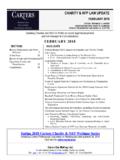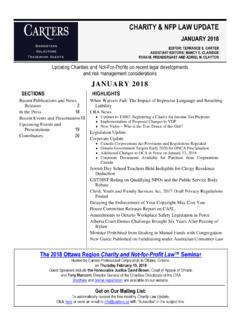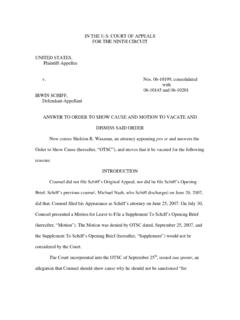Transcription of A Brief But Bright Illumination Of The Truth About …
1 A Brief But Bright Illumination Of The Truth About The income TaxTHE NATURE AND LIMITS OF THE income TAX are not the consequence of the structure ofthe law or definitions therein-- it is, in fact the other way around. However, because thatstructure and those definitions are carefully designed to conform and confine the tax to itsproper nature and limits, understanding the very easily comprehended former brightlyilluminates the more difficult latter (a concise presentation of which can be found within thisdocument; see Cracking the Code- The Fascinating Truth About Taxation In America for acomprehensive treatment).
2 I m going to briefly discuss two definitions in US income tax law-- those given by statute to theterms wages and trade or business . Between them these two terms are integral to the vastmajority of all income -receipt allegations made About these definitions will make clear that the receipts of most Americans don t fallwithin either of these classes. Simple logic recognizes that because receipts that DO fall withinthese special classes are distinguished in the law as being subject to the tax, those receipts thatDON T fall within them are not subject.
3 As Black s Law Dictionary puts it in its 6th edition: Inclusio unius est exclusio alterius. The inclusion of one is the exclusion of another. The certain designation of one person is an absolute exclusion of all others.. Thisdoctrine decrees that where law expressly describes [a] particular situation to which itshall apply, an irrefutable inference must be drawn that what is omitted or excluded wasintended to be omitted or excluded. **LET S FIRST TAKE A LOOK at wages -- a term presented at 26 USC 3401(a) and providedwith a compound definition:Sec.
4 3401. - Definitions (a) Wages For purposes of this chapter, the term ''wages'' means all remuneration (other than feespaid to a public official) for services performed by an employee for his employer,.. (c) Employee For purposes of this chapter, the term employee includes an officer, employee, orelected official of the United States, a State, or any political subdivision thereof, or theDistrict of Columbia, or any agency or instrumentality of any one or more of theforegoing. The term employee also includes an officer of a It is by Sec.
5 1 of the Public Salary Tax Act of 1939 that sec. 22(a) of the Internal Revenue Code (defining "gross income ", and now sec. 61 of the current Code) was expanded to add "including personal service as an officer or employee of a State, or any political subdivision thereof, or any agency or instrumentality of the foregoing". Included in the same act is language applying the tax to officers of corporations, which those affected being (NOTE: Tax law actually contains two definitions of wages , one related to withholding against taxes related to such receipts, and one to the receipts on which FICA and FUTA taxesfall.)
6 While the withholding definition above hinges on the meaning of employee , the FICAand FUTA wage definition at 3121(a) instead hinges on a custom definition of employment found at 3121(b). However, discussing the one suffices for discussing both, foras the US Supreme Court holds in Rowan Cos. v. United States, 452 US 247 (1981), The plainlanguage and legislative histories of the relevant statutes indicate that Congress intended for itsdefinition of wages to be interpreted in the same manner for FICA and FUTA as for income -tax withholding.
7 Thus, while the FICA and FUTA taxes don t fall on all wages subject to thewithholding provisions and in that sense there are two different subclasses of wages , thenature of what qualifies as any kind of tax-relevant wage is the same.) It will be observed that the definition of employee deploys the term includes , rather thanthe more conventional means often found in definitions. The reason for the use of thisspecialized term is to invoke a special rule of construction for includes found at 26 USC 7701(c):(c) Includes and includingThe terms includes and including when used in a definition contained in this title shallnot be deemed to exclude other things otherwise within the meaning of the this rule, the term includes provides for what courts have described as a calculatedindefiniteness.
8 This is the expandability of the meaning of a statutory term to things not listedin the definition (indefiniteness), but only things of the same character as those listed(calculated).explicitly defined in sec. 207 of the act: a corporate agency or instrumentality, is one (a) a majority of the stock ofwhich is owned by or on behalf of the United States, or (b) the power to appoint or select a majority of the board of directors of which is exercisable by or on behalf of the United .Further, the character of all objects in the definition that are specified in that regard is that of government entities, and the canons of statutory construction dictate that the character of the corporate officers referred-to in more general terms must be construed to be the same: [W]here general words follow specific words in a statutory enumeration, the general words are construed to embrace only objects similar in nature to those objects enumerated by the preceding specific words Circuit City Stores v.
9 Adams, 532 US 105, 114-115 (2001); ..a word is known by the company it keeps (the doctrine of noscitur a sociis). This rule we rely upon to avoid ascribing to one word a meaning so broad that it is inconsistent with its accompanying words, thus giving unintended breadth to the Acts of Congress. Gustafson v. Alloyd Co., (93-404), 513 US 561 (1995); Under the principle of ejusdem generis, when a general term follows a specific one, the general term should be understood as a reference to subjects akin to the one with specific enumeration. Norfolk & Western R.
10 Co. v. Train Dispatchers, 499 US 117 (1991),Norfolk & Western R. Co. v. Train Dispatchers, 499 US 117 (1991). a statutory definition, the term defined is stripped of all external meaning, being left withonly the specified meaning given by the custom Normally, what is listed or describedin the custom definition is comprehensive and closed. But under the rule of construction at 26 USC 7701(c), the use of includes allows an indefiniteness to the scope of the customdefinition in that it can embrace things of the same kind as those enumerated even though notlisted, while at the same time being calculated in that such expansion cannot reach beyondthe specialized class illustrated by the enumerated example, under the includes rule the definition of employee at 3401(c)







